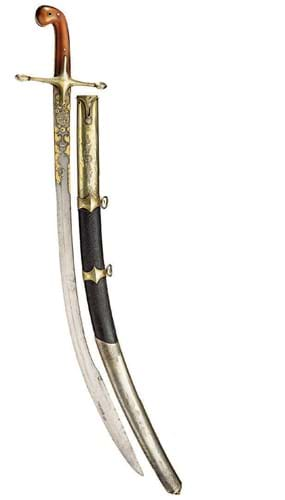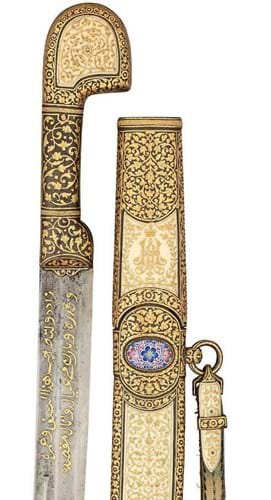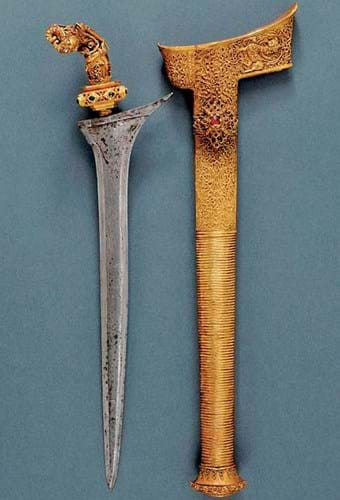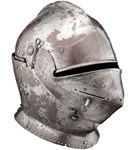
By no means all these exotic blades raise large sums, but each season brings a few choice pieces that reach eye-catching prices.
The five lots shown here originate from different corners of the Eastern hemisphere but all are distinguished by their quality and provenance.
Sultan salute
1. Among the edged weapons offered by Hermann Historica (25% buyer’s premium) in Munich in November was this late-18th century Ottoman kilij inscribed for Sultan Gazi Selim Khan which reached €50,000 (£43,100), pictured top.
It was a particularly fine example of this characteristic Ottoman sabre with its distinctive broad tip yalman in the last quarter of the blade. The killij was inlaid below the quillons in gold with inset cabochon rubies and emeralds and signed with the Sultan’s name and the date 1209 (1794).
Kris is Indonesian star
2. On December 13 Italian auction house Czerny (24.4% buyer’s premium) offered a 498-lot selection of Indonesian swords and daggers on behalf of the German-based International Foundation of Indonesian Culture and Heritage. Pick of them all was this highly decorated kris with a carved yellow metal hilt in the form of a Hindu prince.
It was catalogued as a late-19th or early-20th century replica of the type of dagger made for presentation in the 15th and 16th centuries by the Hindu state of East Java. Though estimated at €1500-2500, competition pushed it all the way to €22,000 (£18,645).
East to West Country

This late-19th or 20th century Sinhalese or Ceylonese Kastane or short sword sold for £2600 at Antony Cribb’s auction on November 12.
3. While a Ceylonese ivory handled ceremonial ladle (kinissa) with copper bowl was the financial star at £17,000 in the Antony Cribb (22% buyer’s premium) auction on November 12 (see Bid Barometer, ATG No 2418), weapons from what is now Sri Lanka also impressed.
This late-19th or 20th century Sinhalese or Ceylonese Kastane or short sword, with a 13½in (34cm) curved blade, sold for £2600 against an estimate of £600-800. Both items came from an established West Country collection.
Sword and spear at Del Mar

This late-19th century Caucasian presentation sabre topped Thomas Del Mar’s sale in London on December 4, selling for £85,000.
4. Though imperial Russian associations helped it to top Thomas Del Mar’s sale in London on December 4, the eastern origins of this late 19th century Caucasian presentation sabre are clear to see. The sword itself is typical of the high quality edged weapons manufactured in the town of Kubachi in Dagestan.
The curved triple-fullered blade is encrusted in gold with couplets in Arabic script, while the blued steel hilt is inlaid with gold scrolling foliage and with an engraved ivory panel at the pommel.
This decorative scheme was continued on the blued steel scabbard and leather belt and it was the scabbard that bore an ivory panel engraved with the Imperial cypher of Tsar Nicholas II. This, together with the overall quality and condition, propelled the sword to £85,000.
5. Swords and daggers are not the only eastern blades that can raise solid prices in the saleroom. While the Caucasian sabre had been expected to do well, this ceremonial Siamese spear had been estimated at £2000-3000 but went on for sell for £22,000 at the Del Mar sale.
Dated to the 18th century, this elegant weapon had a leaf-shaped hollow-ground blade, mounted on an imitation bamboo haft via a long silver-gilt collar with broad bands of leafy niello decoration. It came complete with its lacquered wooden scabbard decorated with gilt flowers and foliage.
















